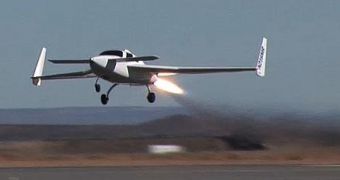Two of the most promising concepts in the quest to establish a future commercial space flight service, the Armadillo and the XCOR rocket planes, designed and built by the Armadillo Aerospace of Mesquite, Texas and by the XCOR Aerospace of Mojave, California, are scheduled to flight a head-to-head race next week, as part of the AA AirVenture air show organized by the Rocket Racing League. RRL is a company founded by X-Prize Foundation chairman Peter Diamandis and Granger Whitelaw, an Indy 500 car race team owner.
There's one problem though: the Armadillo plane hasn't received a flight permit from the Federal Aviation Administration, which could have the XCOR plane fly alone on July 29. "The FAA has been very helpful in trying to accommodate us, but they don't move at rocket speed. They're still on piston power," Whitelaw said, while revealing that there is still no news on whether or not the Armadillo plane will fly next week, although there are no technical problems that we know of. "It's completely ready to fly," he added.
Nonetheless, both rocket planes have been sent to the Oshkosh airfield, Wisconsin, where the air show will take place. Both planes will navigate the course by alternating the thrust produced by their rocket engine with coasting periods to save fuel and maintain a safe speed, since the planes are not designed to withstand velocities greater than 560 kilometers per hour.
The engine equipping the XCOR rocket plane runs on an oxygen and kerosene combustible mixture which takes out the possibility of thrust regulation, unlike the engine of the Armadillo plane which has variable thrust and is fueled with oxygen and ethanol. The characteristics of the engines also vary significantly when it comes to thrust levels, although nobody is sure yet which of the two will be the winner.
Whitelaw believes that the XCOR plane will have a certain advantage over its rival, because it is able to maintain thrust at a steady level, even though its engine produces about 700 pounds of thrust less than that of the Armadillo.
"A big part of this is not the sport and entertainment side of it, but all the different types of technology we're testing," he said, referring to the fact that both companies are involved in operations regarding the development of rockets that could place commercial flights into the low orbit of the planet.
"It's definitely going to be a one-plane demo. XCOR's been working on this for a year and a half, and they've been flying the vehicle since last October. The first time Armadillo had anything on the runway was just within the last couple of weeks," said aerospace engineer Charles Lurio.
If indeed Lurio is right, then the Armadillo rocket plane will most likely fly into the next exhibition race, the Reno National Championship Air Races in Nevada.

 14 DAY TRIAL //
14 DAY TRIAL //